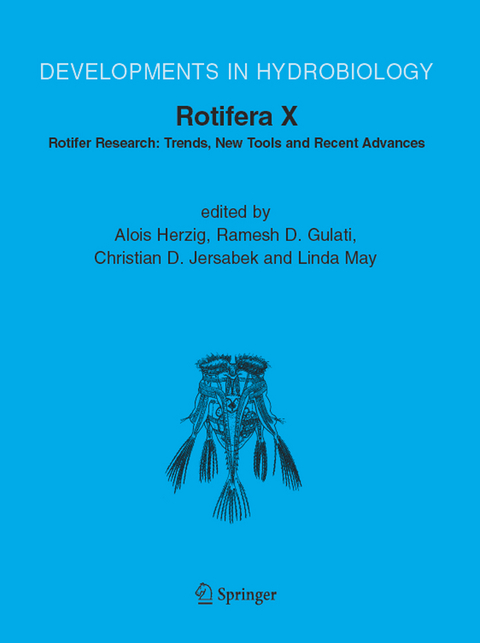
Rotifera X
Springer (Verlag)
978-90-481-6885-9 (ISBN)
Walter Koste - a K-strategist? A laudatio.- Walter Koste - a K-strategist? A laudatio.- Phylogeny and Evolution.- On the phylogenetic position of Rotifera — have we come any further?.- Speciation and selection without sex.- Bayesian and maximum likelihood analyses of rotifer-acanthocephalan relationships.- Evolutionary dynamics of ‘the’ bdelloid and monogonont rotifer life-history patterns.- Toward a better understanding of the phylogeny of the Asplanchnidae (Rotifera).- Genetics and Molecular Ecology.- Molecular ecology of rotifers: from population differentiation to speciation.- The potential of genomic approaches to rotifer ecology.- Using amplified fragment length polymorphisms (AFLP) to study genetic variability in several freshwater rotifer species.- Genetics and Molecular Ecology.- Molecular characterization of Mn-superoxide dismutase and gene expression studies in dietary restricted Brachionus plicatilis rotifers.- Behavioural reproductive isolation in a rotifer hybrid zone.- Taxonomy and Biogeography.- The ‘Frank J. Myers Rotifera collection’ at the Academy of Natural Sciences of Philadelphia.- Tale of a sleeping beauty: a new and easily cultured model organism for experimental studies on bdelloid rotifers.- Life on the edge: rotifers from springs and ephemeral waters in the Chihuahuan Desert, Big Bend National Park (Texas, USA).- Morphology and Ultrastructure.- Euryhaline Brachionus strains (Rotifera) from tropical habitats: morphology and allozyme patterns.- Morphological and morphometrical variations of selected rotifer species in response to predation: a seasonal study of selected brachionid species from Lake Xochimilco (Mexico).- Morphological stasis of two species belonging to the L-morphotype in the Brachionus plicatilis species complex.-Morphological variation of Keratella cochlearis (Gosse) in a backwater of the River Thames.- Trophi structure in bdelloid rotifers.- Study of the trophi of Testudinella Bory de St. Vincent and Pompholyx Gosse (Rotifera: Testudinellidae) by scanning electron microscopy.- Do rotifer jaws grow after hatching?.- External morphology and muscle arrangement of Brachionus urceolaris, Floscularia ringens, Hexarthra mira and Notommata glyphura (Rotifera, Monogononta).- The musculature of Testudinella patina (Rotifera: Flosculariacea), revealed with CLSM.- Rotifer nervous system visualized by FMRFamide and 5-HT immunocytochemistry and confocal laser scanning microscopy.- Identification of acetylcholinesterase receptors in Rotifera.- Mating, Resting Eggs, Diapause, Anhydrobiosis, Embryonic Development.- Brachionus calyciflorus is a species complex: Mating behavior and genetic differentiation among four geographically isolated strains.- Removal of surface glycoproteins and transfer among Brachionus species.- Maternal effect by stem females in Brachionus plicatilis: effect of starvation on mixis induction in offspring.- Restoration of tropical peat swamp rotifer communities after perturbation: an experimental study of recovery of rotifers from the resting egg bank.- Diapause in monogonont rotifers.- Anhydrobiosis of Adineta ricciae: costs and benefits.- A putative LEA protein, but no trehalose, is present in anhydrobiotic bdelloid rotifers.- The development of a bdelloid egg: a contribution after 100 years.- Population and Community Ecology.- Evolution of rotifer life histories.- Insulin-like growth factor signaling pathway involved in regulating longevity of rotifers.- Combined effects of algal (Chlorella vulgaris) food level and temperature on the demography of Brachionus havanaensis (Rotifera): a life table study.- Factors affecting egg-ratio in planktonic rotifers.- Factors affecting swimming speed in the rotifer Brachionus plicatilis.- An evidence for vertical migrations of small rotifers — a case of rotifer community in a dystrophic lake.- Structure distinctions of pelagic rotifer plankton in stratified lakes with different human impact.- Changes in rotifer species composition and abundance along a trophic gradient in Loch Lomond, Scotland, UK.- Diversity and abundance of the planktonic rotifers in different environments of the Upper Paraná River floodplain (Paraná State — Mato Grosso do Sul State, Brazil).- Relationships between rotifers, phytoplankton and bacterioplankton in the Corumbá reservoir, Goiás State, Brazil.- Short time-response of psammic communities of Rotifera to abiotic changes in their habitat.- The influence of biotic and abiotic factors on psammic rotifers in artificial and natural lakes.- Long-term Studies.- Seasonal rotifer dynamics in the long-term (1969–2002) record from Lake Kinneret (Israel).- Seasonality of rotifers and temperature in Lough Neagh, N. Ireland.- Abiotic vs. biotic factors: lessons drawn from rotifers in the Middle Loire, a meandering river monitored from 1995 to 2002, during low flow periods.- Trophic Interactions.- Freshwater copepods and rotifers: predators and their prey.- Trophic Interactions.- Life history characteristics of Asplanchnopus multiceps (Rotifera) fed rotifer and cladoceran prey.- Susceptibility of ephemeral pool Hexarthra to predation by the fairy shrimp Branchinecta mackini: can predation drive local extinction?.- Decline of clear-water rotifer populations in a reservoir: the role of resource limitation.- Combined effects of food concentration and temperature oncompetition among four species of Brachionus (Rotifera).- Application of stable isotope tracers to studies of zooplankton feeding, using the rotifer Brachionus calyciflorus as an example.- Aquaculture and Ecotoxicology.- Screening methods for improving rotifer culture quality.- Interaction among copper toxicity, temperature and salinity on the population dynamics of Brachionus rotundiformis (Rotifera).- Effect of some pesticides on reproduction of rotifer Brachionus plicatilis Müller.- Heat shock protein 60 (HSP60) response of Plationus patulus (Rotifera: Monogononta) to combined exposures of arsenic and heavy metals.
| Reihe/Serie | Developments in Hydrobiology ; 181 |
|---|---|
| Zusatzinfo | XIV, 602 p. |
| Verlagsort | Dordrecht |
| Sprache | englisch |
| Maße | 195 x 260 mm |
| Themenwelt | Naturwissenschaften ► Biologie ► Limnologie / Meeresbiologie |
| Naturwissenschaften ► Biologie ► Ökologie / Naturschutz | |
| Naturwissenschaften ► Biologie ► Zoologie | |
| Naturwissenschaften ► Physik / Astronomie ► Angewandte Physik | |
| ISBN-10 | 90-481-6885-6 / 9048168856 |
| ISBN-13 | 978-90-481-6885-9 / 9789048168859 |
| Zustand | Neuware |
| Haben Sie eine Frage zum Produkt? |
aus dem Bereich


